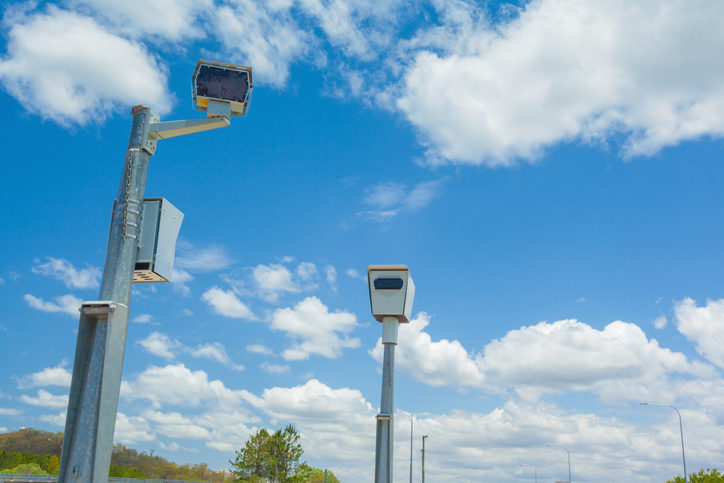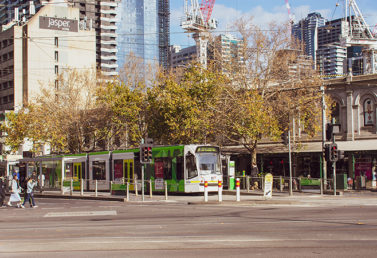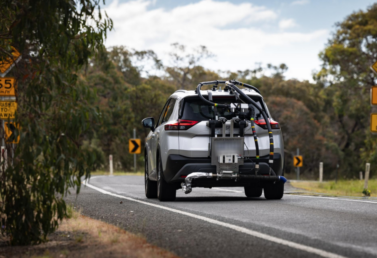John Crozier, chair of the RACS trauma committee, speaks about extending point-to-point speed cameras to cover all vehicles.

Michael McLaren: Well according to the nation’s top surgeons the NSW Government’s refusal to extend point to point speed averaging cameras from trucks to include cars is illogical. A statement by the Royal Australasian College of Surgeons Trauma Committee late last week said that evaluations of speed averaging cameras or what we would call point to point cameras around the world had shown that they cut speeding infringements, serious injuries and even deaths from road accidents once in place. Well the chair of the RACS trauma committee is Dr John Crozier. Now he also happens to be the bloke heading the Federal Government’s inquiry into road safety, and as he says the NSW decision to only use point to point for heavy vehicles simply didn’t make sense when the infrastructure was already in place. I have to say I agree 100 percent, and I’ve never understood the logic as to why the technology is not extended to cars. I’m glad to say John Crozier joins me on the line.
Dr John Crozier: It’s a pleasure, Michael.
Michael McLaren: I remember speaking with Melinda Pavey, the Roads Minister, and raised this very issue with her less than a month ago and she said to me well we need to be able to bring the community with us when we make changes to road infrastructure like the changes being proposed by you and myself and others and that is the point to point camera technolgy should be extended to snap cars speeding between two fixed points as well as trucks. For the life of me I don’t understand what she means by that because the community is in pretty much full agreement. Do you understand?
Dr John Crozier: The community was in complete agreement back in 2011 when this current decade of the National Road Safety Strategy was actually enacted. And the community was consulted as well a range of other stakeholders and all agreed back in 2011, and in fact every Transport and Infrastructure Minister for every jurisdiction in Australia signed on to the incorporation of point to point average speed safety systems as an essential part of implementation of the safety strategy for this current decade.
Michael McLaren: Yeah, I mean the argument that seems to bubble out when you drill down into this, and I can’t confirm or deny it as I said to the minister at the time, but it does seem that there’s a bunch of National Party MPs reluctant in their constituencies where most of these point point cameras operate extending the technology to cars. Have you heard that on the grapevine?
Dr John Crozier: I think the important thing to recognize is that most in the community actually think they are being subject to the same enforcement that heavy vehicles on these segments of road are. So most of the population that drives on the road systems actually drive within legal limits. Most believe that they are functional and I think it comes as a surprise to many in New South Wales to learn that they’re only being used to enforce heavy vehicles. We are the only jurisdiction where this selective use of them is actually the case.
Michael McLaren: Yeah, I mean the argument that seems to bubble out when you drill down into this, and I can’t confirm or deny it as I said to the minister at the time, but it does seem that there’s a bunch of National Party MPs reluctant in their constituencies where most of these point point cameras operate extending the technology to cars. Have you heard that on the grapevine?
Dr John Crozier: I think the important thing to recognize is that most in the community actually think they are being subject to the same enforcement that heavy vehicles on these segments of road are. So most of the population that drives on the road systems actually drive within legal limits. Most believe that they are functional and I think it comes as a surprise to many in New South Wales to learn that they’re only being used to enforce heavy vehicles. We are the only jurisdiction where this selective use of them is actually the case.
Michael McLaren: Yes I suppose it would come as a surprise to people interstate because they would be used to the cameras not just getting trucks but also them in cars.
Dr John Crozier: Very much so and that was the design intent. As I say the evidence back in 2011 was clearly in favour of them for all road users. There is an automated continuous and same standard element of what is a safe system. Most people who drive on segments of the road where these are in place feel safer.
Michael McLaren: Now a jurisdiction very similar to ours, the British in the United Kingdom, they’ve had I think at least five years of this point to point technology in place not just targeting trucks but also motor vehicles. The results are in. They seem pretty decent results.
Dr John Crozier: It’s dramatic, reductions of between 30 and 50 percent of fatalities on segments of road prior and after the implementation of these. And these are sustained significant dramatic reductions in fatalities and serious injuries. In fact the UK evidence the early experience out of the United Kingdom helped inform the science of the community and other stakeholders decisions back in 2011 to incorporate these technologies. Now the technologies have actually got safer and much more efficient. They are a much fairer way of calming and controlling flows of traffic. There are very few that actually drive illegally, but they pose significant and great hazard to themselves and to other road users.
Michael McLaren: Is it also the case, John, that there’s an irony, a very rich irony, in this debate particularly in NSW because I see people listening in the rest of the country to this would be saying “What the hell you’re talking about, they catch cars” well not in NSW these cameras don’t yet NSW has the most point to point cameras for any jurisdiction I think we’ve got 24 in place don’t we.
Dr John Crozier: Yeah there are 25 and they have been implemented well. So there’s a five year period before they’re turned on and five years after and we’ve had dramatic reductions in the fatalities on those segments. So there are 333 heavy vehicle and serious injuries involving heavy vehicles prior to the implementation of these across the 25 systems. That was reduced dramatically to 199, a 30 percent reduction in a sustained way for the five years after the implementation. And that’s only looking at the segment where a heavy vehicle has been involved in the fatality or a serious injury. We don’t in the public domain have the crashes and the fatalities that involved light vehicles or the seriously injured coming light vehicle alone. That data is available and that’s part of why there’s such a strong plea. The Australian Trucking Association had written to Premier Baird, when he was the incumbent premier, a range of other agencies understand and accept these are system that does work. We’re not actually gaining the full advantage by selectively using them for heavy nickel.
Michael McLaren: I mean a sporting analogy would be saying well you’ve got a really good team but you’re not really using your half back in the full back to its full potential, you know, you’re sort of saying “I’ll just pass the ball occasionally”. It’s dumb.
Dr John Crozier: Yeah we’ve got some of our best players sitting on the reserve bench.
Michael McLaren: Well I’m trying to get back to where we started here, John, to understand why that’s the case. I mean as I say you’ve got connections with the federal government, in fact you’re the chair of the Federal Government inquiry into road safety, and you’ve been at this place for years. Why is it that when these cameras were first rolled out in NSW, unlike in other jurisdictions, it was only heavy vehicles that were to be snapped? What was the reason given?
Dr John Crozier: There have been a number of statements. I don’t think as the science is dispassionately explored there is a convincing argument to fail to turn them on and it is truly as simple as that. The technology actually allows it. We know for each truck that infringes and is issued an enforcement notice there are 800 or more light vehicle users who in a period under a Freedom of Information request were driving not just beyond the legal limit but they’d exceeded the discretionary threshold. Not a brief lapse of concentration, but a sustained desire to travel illegally across quite the length of the road system.
Michael McLaren: I mean a sporting analogy would be saying well you’ve got a really good team but you’re not really using your half back in the full back to its full potential, you know, you’re sort of saying “I’ll just pass the ball occasionally”. It’s dumb.
Dr John Crozier: Yeah we’ve got some of our best players sitting on the reserve bench.
Michael McLaren: Well I’m trying to get back to where we started here, John, to understand why that’s the case. I mean as I say you’ve got connections with the federal government, in fact you’re the chair of the Federal Government inquiry into road safety, and you’ve been at this place for years. Why is it that when these cameras were first rolled out in NSW, unlike in other jurisdictions, it was only heavy vehicles that were to be snapped? What was the reason given?
Dr John Crozier: There have been a number of statements. I don’t think as the science is dispassionately explored there is a convincing argument to fail to turn them on and it is truly as simple as that. The technology actually allows it. We know for each truck that infringes and is issued an enforcement notice there are 800 or more light vehicle users who in a period under a Freedom of Information request were driving not just beyond the legal limit but they’d exceeded the discretionary threshold. Not a brief lapse of concentration, but a sustained desire to travel illegally across quite the length of the road system.
Michael McLaren: So technologically, for those that are skeptical, it’s not a big task to just include cars it’s literally the flick of a switch is it?
Dr John Crozier: Correct. It’s literally a flick of a switch. Every other jurisdiction does use them in that way. Now to NSW’s credit per head of population many more of these have actually been implemented, commissioned and utilized with good affect many other jurisdictions have been fairly slow. Western Australia for example has only recently completed a trial of one the first of those commissioned on the Forest Highway. But really dramatic reductions already and fatalities and serious injury under the conditions of the trial. These systems do work. They are fair, and the recurrent costs of implementation have diminished dramatically.
Michael McLaren: Just before you go it’s not a complete whack to the NSW Government though and you’ve been very fair in your commentary, John. I mean the RACS in their recent statements also welcomed the move in the state of New South Wales to adapt speed camera technology to identify drivers using mobile phones. But again it does seem ironic doesn’t it that they’re willing to extend the full utilisation of speed cameras for that yet they’re not willing to extend the full utilization of point to point cameras for cars.
Dr John Crozier: Yeah I think it’s to the great credit of the state that they have been prepared to implement the automated enforcement to encourage non distracted driving. They’ve done this well, put out into the public domain the numbers of people who had been photographed in a range of driving tasks particularly across the Sydney Harbour Bridge. The public have been gently informed that there are technologies that sit monitoring and tracking and we know with a high probability the uptick in deaths and serious injury on our roads in Australia in the last two years and in many of the rest of the parts of the world. Distraction is a significant element of the increased numbers of fatalities and serious injuries. So to the tremendous credit of NSW Government the implementation now of an automated and continuous but same standard method of enforcement for encouraging non distracted driving is reasonably anticipated to reduce death and serious injury and that is to the tremendous credit that the government.
Michael McLaren: Just before you go one last one, John. People say “Oh well look, if this is rolled out to cars it’s just another revenue raising mechanism for the government. We hate speed cameras. Doesn’t matter what they are point to point or stationary or unidentified or whatever.” What’s your comment to that.
Dr John Crozier: Yeah that is a common statement but it’s not the fact and it’s important to know that safety isn’t a popularity contest and these systems are not about revenue raising. But the analogy, if we were implementing seatbelts in the way that we are point to point speed systems we would still have vehicles coming into this country not fitted for seatbelts. We would have had thousands still being killed on our roads. Now the analogy is pretty comparable to the way as I say around the country we have rolled these systems out. Some states have been slow in putting them in place. NSW can’t and hasn’t reaped the full reward of extension to all vehicles. It’s a two word change in the act. That’s all that’s required, a change in the act from heavy vehicle to all vehicle. Very much in the spirit of the agreement in 2011 when we all signed on the National Road Safety Strategy the current one which finishes in 2020
Michael McLaren: It seems logical to you, it certainly seems logical to me, I think it seems logical to most listeners, if only it was logical to Macquarie Street. John, I thank you for your time this morning, much appreciated.

The latest AAA Transport Affordability Index reveals transport cost rises exceeded the consumer price index not only in the September 2023 quarter but also over the 12 months to the end of September.
read more
Initial results of Australia’s first program to test vehicle real-world performance show the cars tested use up to 13% more fuel on the road than they did in lab tests reported by manufacturers.
read more
The quarterly update of the AAA’s EV Index shows the Australian new vehicle market continuing to change.
read more